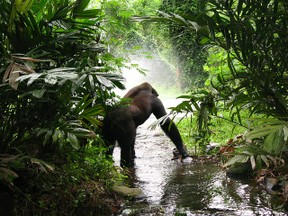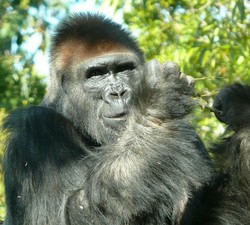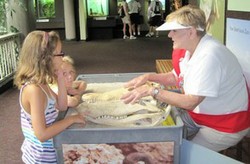 Gorillas live in Africa, excepting their relatives that can be found in captivity all around the world. But in the wild, they live in Africa.
Gorillas live in Africa, excepting their relatives that can be found in captivity all around the world. But in the wild, they live in Africa.
Of course it goes a little deeper than that. There are three different breeds of gorillas, each claiming a different part of Africa for its home.
The Western Lowland Gorilla: This race of gorilla can be found in Equatorial Guinea, Congo, Cameroon, Gabon, and the Central Africa Republic. This group of apes have a brownish gray coat, and the male’s white saddle goes all the way to the rear and upper thighs.
The Eastern Lowland Gorilla: This breed can be mainly found in Zaire. Its coat is black, but for the male’s customary white saddle which is restricted to their backs with this race.
The Mountain Gorilla: We bet you can guess where to find the mountain gorillas, can’t you? Yup, in the mountains! You’ll find them in the higher altitudes of Zaire, Rwanda, and Uganda. They resemble the Eastern breed, but their arms are a bit shorter and their hair a bit longer.
Image Credit: Pixabay, Public Domain


 Gorillas live in Africa, excepting their relatives that can be found in captivity all around the world. But in the wild, they live in Africa.
Gorillas live in Africa, excepting their relatives that can be found in captivity all around the world. But in the wild, they live in Africa.







 Resin Adirondack Chairs: A Comfy and Durable Alternativeon 05/24/2013
Resin Adirondack Chairs: A Comfy and Durable Alternativeon 05/24/2013
 Dr Seuss Stuffed Animals: My Favorite Characters in Plushon 05/23/2013
Dr Seuss Stuffed Animals: My Favorite Characters in Plushon 05/23/2013
 How to Make Beeswax Candles for Fun and Giftingon 05/09/2013
How to Make Beeswax Candles for Fun and Giftingon 05/09/2013
 Latch Hook Kits: A Fun and Easy Craft for the Crafty-Challengedon 05/04/2013
Latch Hook Kits: A Fun and Easy Craft for the Crafty-Challengedon 05/04/2013



Wouldn't You Love to Talk to Koko?
Love the video on Koko. She is so amazing. Gorillas in general as amazing animals.
Koko is a really cool gorilla. I had no idea these creatures were such an amazing species.
I'm with you, Bloomingrose. I'd absolutely love the opportunity to talk with Koko in person. She really is an incredibly intelligent and loving animal. We even have something in common--we both love Manx cats!
Thank you! I love finding pages where I can learn too. I'm finding that Wizzley is great for that!
Absolutley! I love gorillas.
Very informative and well put together - great to learn something new :-)
I know. She simply fascinates me!
I had forgotten all about Koko. What an amazing gorilla.